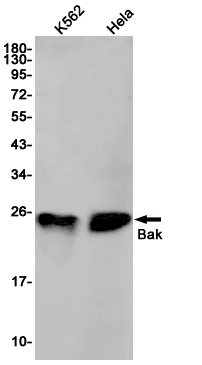

| WB | 咨询技术 | Human,Mouse,Rat |
| IF | 1/20 | Human,Mouse,Rat |
| IHC | 1/50-1/100 | Human,Mouse,Rat |
| ICC | 技术咨询 | Human,Mouse,Rat |
| FCM | 咨询技术 | Human,Mouse,Rat |
| Elisa | 咨询技术 | Human,Mouse,Rat |
| Aliases | BAK1; BAK; BCL2L7; CDN1; Bcl-2 homologous antagonist/killer; Apoptosis regulator BAK; Bcl-2-like protein 7; Bcl2-L-7 |
| Entrez GeneID | 578 |
| WB Predicted band size | Calculated MW: 23 kDa; Observed MW: 23 kDa |
| Host/Isotype | Rabbit IgG |
| Antibody Type | Primary antibody |
| Storage | Store at 4°C short term. Aliquot and store at -20°C long term. Avoid freeze/thaw cycles. |
| Species Reactivity | Human |
| Immunogen | A synthetic peptide of human Bak |
| Formulation | Purified antibody in TBS with 0.05% sodium azide,0.05%BSA and 50% glycerol. |
+ +
以下是关于Bak抗体的3-4篇参考文献及其摘要概述:
1. **"Bak: A novel pro-apoptotic protein of the Bcl-2 family"**
*Kiefer, M. C. et al. (1995)*
该研究首次克隆并鉴定了Bak蛋白,证明其属于Bcl-2家族,具有促凋亡功能,可通过与抗凋亡蛋白(如Bcl-2和Bcl-xL)相互作用激活线粒体凋亡途径。
2. **"BID-induced structural changes in BAK promote apoptosis"**
*Moldoveanu, T. et al. (2006)*
通过结构生物学手段解析了Bak蛋白在凋亡过程中的构象变化,发现BID蛋白激活Bak后导致其寡聚化,进而引发线粒体外膜透化(MOMP),释放细胞色素c。
3. **"Bak and Bax function to limit adenovirus replication through apoptotic cell death"**
*Sarosiek, K. A. et al. (2018)*
研究揭示了Bak在抗病毒免疫中的作用,发现Bak/Bax双敲除细胞对腺病毒感染更敏感,表明Bak通过诱导感染细胞的凋亡限制病毒复制。
4. **"Distinct BH3 domains differentially activate Bak and Bax in apoptosis"**
*Du, H. et al. (2011)*
该文献探讨了不同BH3-only蛋白(如Bim、Puma)对Bak和Bax的激活机制差异,为开发靶向Bak的癌症治疗策略提供了理论依据。
(以上文献为示例,具体引用需核对原文信息)
**Background of Bak Antibodies**
Bak (Bcl-2 homologous antagonist/killer) is a pro-apoptotic protein belonging to the Bcl-2 family, which regulates mitochondrial outer membrane permeabilization (MOMP) during intrinsic apoptosis. Structurally, Bak contains conserved Bcl-2 homology (BH) domains, including the critical BH3 domain essential for its apoptotic function. In healthy cells, Bak remains inactive, anchored to the mitochondrial membrane, and is restrained by interactions with anti-apoptotic Bcl-2 family members like Bcl-2 and Bcl-xL.
Upon cellular stress (e.g., DNA damage), pro-apoptotic signals (e.g., BH3-only proteins such as Bim or Bid) disrupt these interactions, triggering Bak activation. Activated Bak undergoes conformational changes, oligomerizes, and forms pores in the mitochondrial membrane, enabling cytochrome *c* release. This initiates caspase activation and apoptotic cell death.
Bak antibodies are tools used to detect Bak expression, localization, and activation status in research and diagnostics. Dysregulation of Bak is implicated in diseases; reduced Bak levels are linked to cancer progression (apoptosis resistance), while excessive Bak activity may contribute to neurodegenerative disorders. Studies also explore Bak as a therapeutic target, with agents designed to modulate its activity to restore apoptosis in malignancies.
Overall, Bak antibodies play a pivotal role in elucidating apoptotic mechanisms and developing strategies to target apoptosis-related pathologies.
×